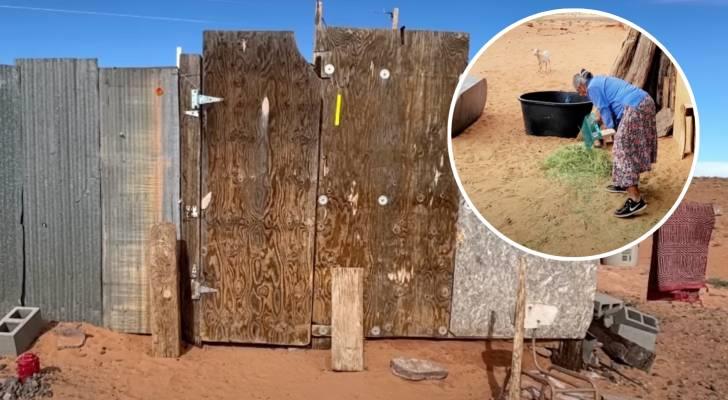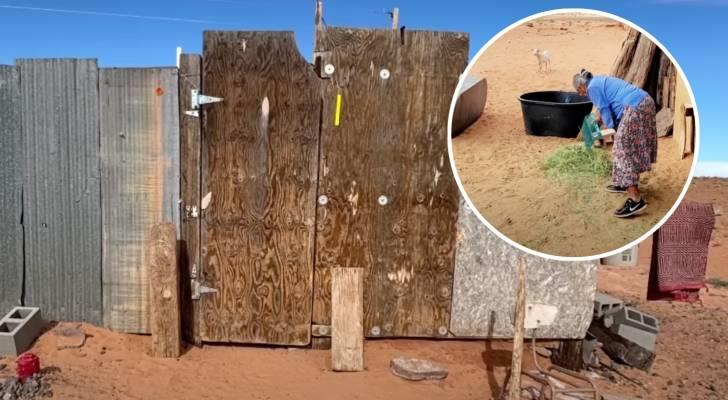
Navajo Elder Lived In Dirt-Floor Shack With No Electricity For 77 Years - Now She's Finally Getting A Real House. How Her Dream Came True In Her 80S

For most of her life, Victoria Benally has lived in a one-room shack with dirt floors, a leaking roof and walls patched with blankets and plastic.
Up until three years ago, the home had no electricity.
Must Read-
Thanks to Jeff Bezos, you can now become a landlord for as little as $100 - and no, you don't have to deal with tenants or fix freezers. Here's how
I'm 49 years old and have nothing saved for retirement - what should I do? Don't panic. Here are 6 of the easiest ways you can catch up (and fast)
Dave Ramsey warns nearly 50% of Americans are making 1 big Social Security mistake - here's what it is and 3 simple steps to fix it ASAP
Now in her 80s, Benally is finally getting a new home: a modular unit with bedrooms, a bathroom, a kitchen and working utilities.
Benally is one of 84 Navajo elders selected to receive housing through a $14-million American Rescue Plan Act (ARPA) initiative managed by the Navajo-Hopi Land Commission.
The program delivers modular homes to older residents in isolated parts of the Navajo Nation who have long lacked reliable housing. Commission director Sarah Slim said the effort represents“stability, dignity and hope for our Navajo people.”
Benally's property, like many in the area, is difficult to reach. Soft sand and steep terrain make the road nearly impassable without four-wheel drive, and even ambulances struggle to access it.
In 2022, a local initiative funded by the Indian Community Development Block Grant and the Navajo Tribal Utility Authority extended power lines to her neighborhood, connecting 18 homes to the grid for the first time. She still has no running water.
The new home will come equipped with plumbing, but crews will need to extend utility lines to reach her remote site - a task that can cost tens of thousands of dollars. Slim said the project's budget did not include a separate allocation for infrastructure, so the commission is seeking additional support to fill those gaps.
Community advocate Angelita Nez, who helped push for Benally's inclusion in the program, said she expects delivery before winter.“She has a house with her name on it,” Nez tells KTVB7.“It's just a matter of getting it to her.” [1]
Local fix points to a national challengeBenally's new home represents more than one family's long wait - it highlights how infrastructure and housing shortages intersect in many parts of the U.S., particularly across rural and Indigenous lands.
For the Navajo Nation, the problem is rooted in decades of federal restrictions. From 1966 to 2009, the Bennett Freeze banned construction and improvements across roughly 1.5 million acres of Navajo land. The freeze was intended to resolve land disputes but effectively halted development for more than 40 years, leaving many communities without basic housing and utilities [2], [3].
The ARPA-funded modular housing program is one of several recent attempts to reverse those effects. Earlier this year, the Navajo Nation allocated $24 million to expand modular manufacturing capacity near Page, Arizona, to produce more prefabricated homes for tribal residents [4].
Still, these programs face the same constraints seen nationwide: high building costs, supply bottlenecks and gaps in infrastructure that prevent affordable housing from being deployed at scale.
Across the U.S., the median home sale price was about $439,000 as of August 2025, according to Redfin [5]. Mortgage rates remain elevated, and the housing deficit reached roughly 4.7 million units in 2023, Zillow reports [6].
Read more: How much cash do you plan to keep on hand after you retire? Here are 3 of the biggest reasons you'll need a substantial stash of savings in retirement
That combination has put homeownership out of reach for many households - and spurred interest in faster, lower-cost building techniques like modular housing.
These homes are built in sections in factories, transported and assembled on-site, allowing for consistent quality control and shorter construction timelines.
Colorado-based modular builder Fading West says it can complete homes in half the time and at up to 20% lower cost than conventional builds, according to CNBC [7]. The company partnered with FEMA in 2023 to deliver modular housing for wildfire survivors in Maui - marking the first time the agency used modular structures instead of trailers.
Even so, modular homes accounted for just 3% of new single-family completions in 2024, based on U.S. Census data analyzed by the National Association of Home Builders [8]. The limited market share reflects regulatory barriers and the challenge of matching homes with prepared land and infrastructure - the same issue confronting Benally's rural community.
Bridging the“last mile”Experts say modular construction's potential depends on how effectively governments and developers coordinate utility access, zoning and transportation. A home may be delivered quickly, but without water, sewer and road access, it can't be occupied. That's the key takeaway from the Navajo-Hopi project: the housing component can be manufactured, but the infrastructure still needs to be built.
For Benally, those final steps are now underway. When the house arrives, she'll have solid flooring, proper insulation and the first indoor plumbing she's ever had.
It's a small but significant change - and one that underscores how solving the housing shortage will require investment not just in buildings, but in the systems that make them livable.
What to read next-
Warren Buffett says you can't buy time - but landlords are finding a way. Here's how savvy real estate investors are avoiding 12 hours a month in tedious admin (for free)
There's still a 35% chance of a recession hitting the American economy this year - protect your retirement savings with these 5 essential money moves ASAP
This tiny hot Costco item has skyrocketed 74% in price in under 2 years - but now the retail giant is restricting purchase. Here's how to buy the coveted asset in bulk
Want an extra $1,300,000 when you retire? Dave Ramsey says this 7-step plan 'works every single time' to kill debt, get rich in America - and that 'anyone' can do it
Join 200,000+ readers and get Moneywise's best stories and exclusive interviews first - clear insights curated and delivered weekly. Subscribe now.
Article sourcesWe rely only on vetted sources and credible third-party reporting. For details, see our editorial ethics and guidelines. KTVB (1); Navajo-Hopi Land Commission (2); U.S. Bureau of Indian Affairs (3); ManufacturedHomes (4); Redfin (5); Zillow (6); CNBC (7); NAHB (8)
This article provides information only and should not be construed as advice. It is provided without warranty of any kind.
Legal Disclaimer:
MENAFN provides the
information “as is” without warranty of any kind. We do not accept
any responsibility or liability for the accuracy, content, images,
videos, licenses, completeness, legality, or reliability of the information
contained in this article. If you have any complaints or copyright
issues related to this article, kindly contact the provider above.
Most popular stories
Market Research

- Pepeto Highlights $6.8M Presale Amid Ethereum's Price Moves And Opportunities
- Codego Launches Whitelabel Devices Bringing Tokens Into Daily Life
- Zeni.Ai Launches First AI-Powered Rewards Business Debit Card
- LYS Labs Moves Beyond Data And Aims To Become The Operating System For Automated Global Finance
- Whale.Io Launches Battlepass Season 3, Featuring $77,000 In Crypto Casino Rewards
- Ceffu Secures Full VASP Operating License From Dubai's VARA



















Comments
No comment